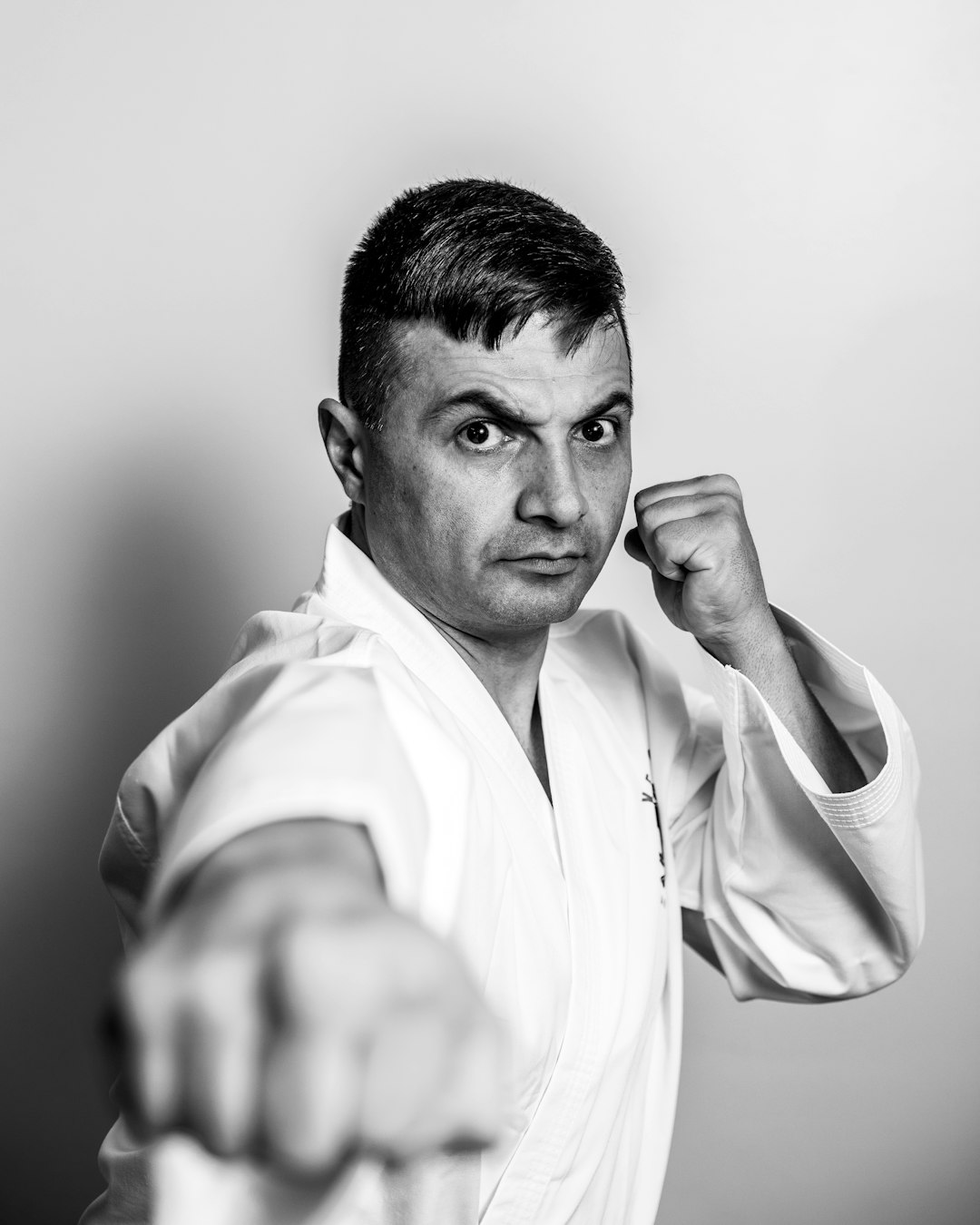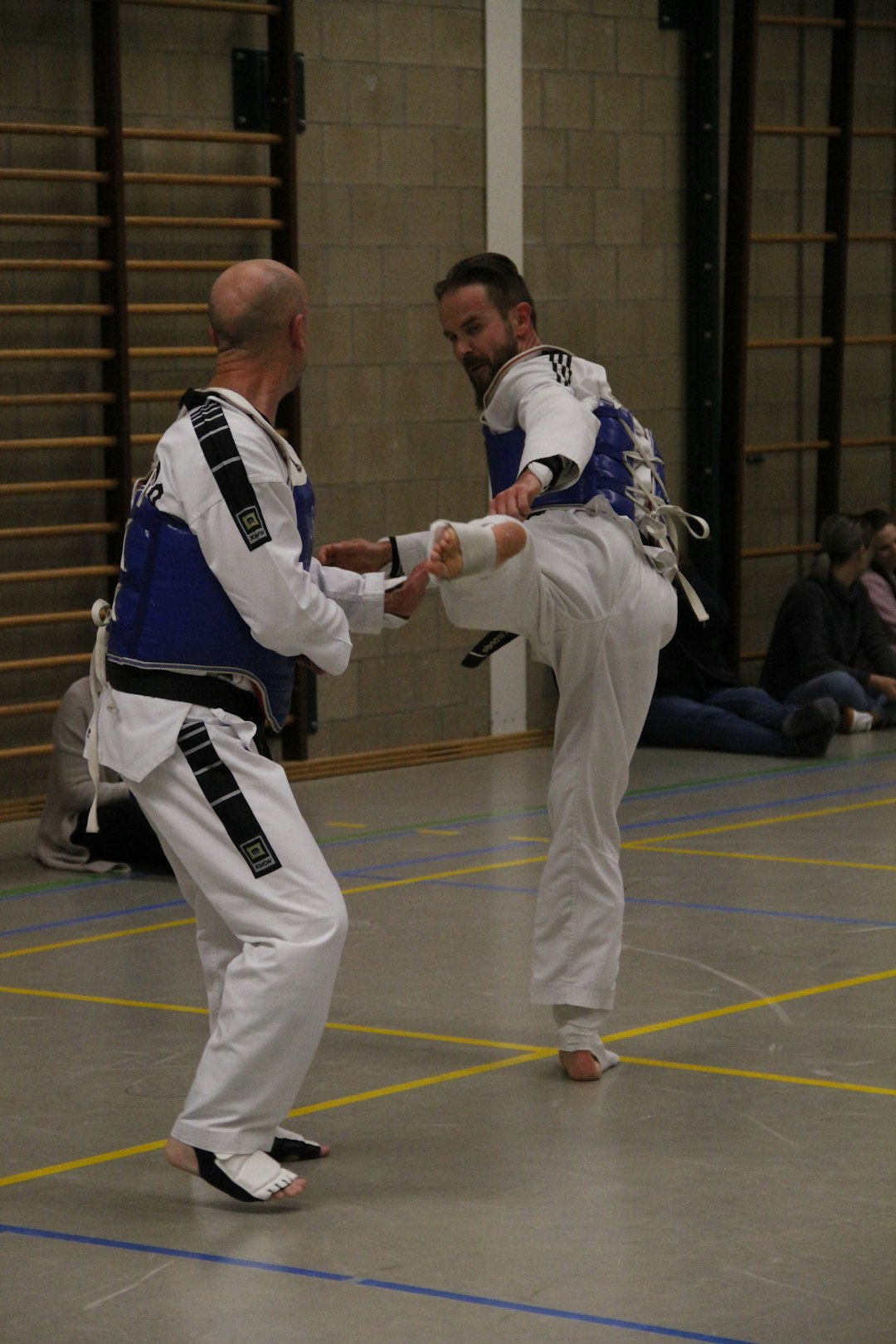The karate suit, known as a keikogi or gi, is a fundamental element of traditional karate practice. It has evolved from its early 20th-century origins in Okinawa to become an emblem of respect and unity within the martial art community. While initially a functional garment made of cotton or hemp, the modern gi includes an obi and color coding to indicate rank, with white representing novices and red/black signifying higher achievements. The gi's fabric, often a blend of materials like polyester for durability and ease of care, must balance traditional values with contemporary needs. A proper karate suit should offer both comfort and functionality, allowing for unrestricted movement during practice. It is available in different weights, catering to various training conditions and personal preferences. Selecting the right gi involves considering its fit, material, and color code, ensuring it aligns with the karate community's standards and enhances your training experience. The name "karate suit" encompasses the rich history, cultural significance, and practical aspects of this essential martial arts attire.
Exploring the essence of martial arts, an integral aspect is the attire that practitioners don. A karate suit, known as a ‘Gi,’ serves as more than mere clothing; it’s a symbol of tradition and respect in the discipline. This article delves into the world of karate suits, shedding light on their fabric, design, and evolution from ancient practices to contemporary use. Understanding the significance of a Gi is crucial for any martial artist, whether just starting or well-versed in the art. Join us as we unravel the key features that define a traditional karate suit and guide you through selecting the perfect Gi for your practice.
- Understanding the Karate Suit: A Glimpse into Gi Fabric and Design
- The Evolution of the Karate Gi: From Traditional to Modern Usage
- Key Features of a Karate Suit: What Constitutes a Traditional Gi
- Selecting the Perfect Karate Suit: Factors to Consider for Beginners and Experienced Practitioners Alike
Understanding the Karate Suit: A Glimpse into Gi Fabric and Design

When exploring the realm of traditional martial arts, one term frequently encountered is the “karate suit,” often referred to by its Japanese name, “keikogi” or “gi.” This garment is central to the practice as it allows for optimal movement during training and performance. The karate suit, or gi, typically consists of a jacket and trousers made from cotton or hemp fabric, providing durability and comfort. Does the karate suit name vary by style or region? Indeed, while the basic design remains consistent across different styles of karate, there can be subtle variations in the cut and fit depending on the specific tradition being practiced. In Okinawan styles, for instance, the jacket might be slightly longer, whereas in Shotokan karate, the gi is often more fitted. The fabric choice also plays a role in the suit’s performance; lightweight cotton or a hemp-cotton blend is favored for its breathability and ability to absorb perspiration, making it an ideal garment for the demands of karate practice. What material properties contribute to the effectiveness of a karate suit? The fabric must be sturdy enough to withstand repeated movements and falls yet lightweight and flexible enough to allow for a full range of motion. These design considerations ensure that the karate suit, or gi, remains a functional and integral part of the martial art’s practice.
The Evolution of the Karate Gi: From Traditional to Modern Usage

The evolution of the karate suit, commonly referred to as a gi, is a testament to the adaptability and cultural significance of this traditional martial arts attire. Historically, the karate gi has its roots in Okinawa, where it was initially designed for practical purposes during the 20th century, as a response to the need for standardized training wear that could be easily produced and worn by practitioners. Over time, the design of the karate gi has undergone subtle yet significant changes. What is the karate suit name and how have these modifications affected its use in modern practice?
The original karate gi was simple in design, typically consisting of a jacket and trousers made from cotton or hemp. It featured no belt, known as an obi, which was later added for both functional and aesthetic reasons. The evolution of the gi has seen it transition from being a plain garment to one that carries specific color codes, with white often used for formal training, red for high-ranking belts, and black for dan (black belt) levels, signifying rank and achievement within the martial art. Today’s karate gi retains elements of its traditional heritage while also incorporating modern materials like polyester for durability and easier maintenance. What has driven these changes in the karate suit name and design? The drive behind these evolutions is a blend of preserving tradition, meeting the demands of practicality, and adapting to the needs of contemporary karateka (practitioners).
Key Features of a Karate Suit: What Constitutes a Traditional Gi

When practicing the disciplined art of karate, the traditional attire worn by practitioners is known as a gi. A karate suit, or gi, is a garment that not only signifies respect for the martial art but also serves as a standardized uniform across various schools and styles. Key features of a traditional karate gi include its fabric, cut, and color. Typically, a karate suit is made from heavyweight cotton or a cotton-blend material, which provides durability and comfort during training. The jacket, known as the “uwagi,” is buttoned up the front and reaches just above the waist, fastening with ties, or “obi,” around the torso. It features long sleeves that are rolled up during practice to expose the forearms for full range of motion. The trousers, called “hakama” in some martial arts, are straight-legged and secured at the waist with belts, or “belt,” which also signify the practitioner’s rank within the discipline. The top and trousers are usually white, symbolizing purity and neutrality, and are designed to allow for a full range of motion without restricting the practitioner’s movements. What constitutes a traditional karate gi is not solely about the aesthetic but also about the functionality and respect for tradition that it embodies. Does the karate suit you are considering adhere to these traditional features? If so, it will likely be recognized as a legitimate gi within the karate community. A karate suit name that reflects its purpose and tradition is essential for practitioners to maintain the integrity of the martial art as they train.
Selecting the Perfect Karate Suit: Factors to Consider for Beginners and Experienced Practitioners Alike

When selecting a karate suit, also known as a gi, it’s crucial to consider both comfort and functionality, whether you’re a novice or an experienced practitioner. The gi should fit properly, allowing for a full range of motion during practice. For beginners, the fundamental aspects to focus on are the sizing and material of the suit. How does the gi drape on your body? Is it too tight or too loose, restricting your movements? A well-fitting karate suit should be snug yet not overly constraining, ensuring that you can perform techniques with ease. The material’s weight also plays a significant role; lighter fabrics are more suitable for summer training, while heavier materials offer more coverage and durability for colder climates or intense training sessions. Experienced practitioners may prioritize additional factors such as the gi’s ability to withstand repeated use and the quality of its construction. Is the stitching robust enough to endure the stresses of karate practice? Does the color comply with the dojo’s standards, if applicable? Selecting the perfect karate suit is a personal decision that balances comfort, durability, and adherence to traditional or practical requirements, ensuring that you can fully engage in your martial arts practice without hindrance. Does the suit meet your specific needs for training intensity and environmental conditions? Ensuring that your karate suit, or gi, aligns with these factors will contribute significantly to an effective and enjoyable training experience.
In conclusion, the karate suit, commonly known as a gi, is more than mere attire; it is a cornerstone of tradition and functionality within the martial art of karate. From its origins to its modern-day iterations, the evolution of the karate gi reflects both cultural significance and practical adaptation. A traditional karate suit typically consists of a jacket, trousers, and belt, each crafted from cotton or hemp fabric for durability and comfort during practice. When selecting a karate suit, whether you are a novice or an experienced practitioner, it is crucial to consider the quality of the material, fit, and adherence to the traditions that honor the discipline’s heritage. Understanding the karate suit’s name and its significance can enhance your experience and respect for the practice. Whether in the dojo or competition, the karate gi remains an integral part of the martial artist’s identity and a testament to the unity of form and function that karate embodies.
